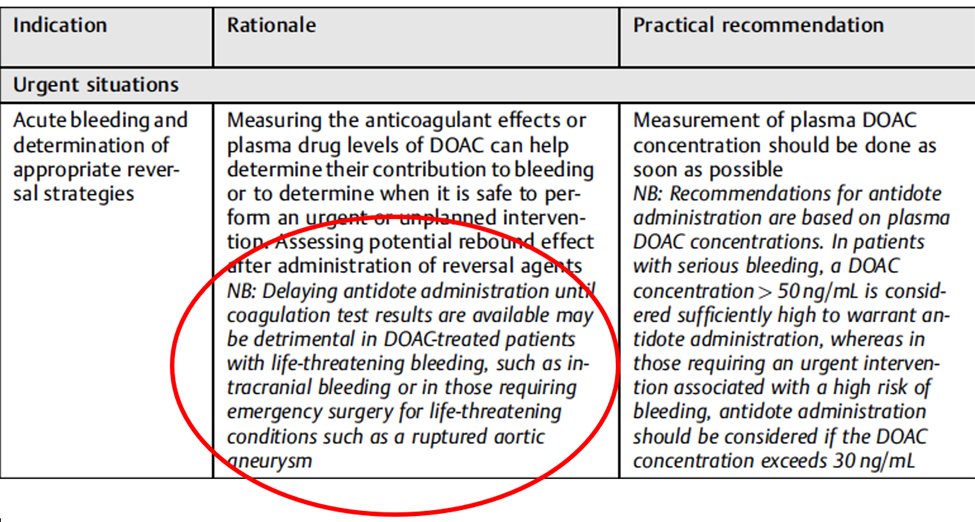
1a) Welcome to a new #accredited #tweetorial on the management of aFXa-DOAC-associated #hemorrhage and specifically the role of coag laboratory testing in these challenging cases. 

1b) Our expert author is #pharmacist Craig Beavers, PharmD @beaverspharmd CV Clinical Pharmacy Specialist @UK_COP, and Immediate Past Chair of the @ACCinTouch #ACCCVT Section 

2) This 🆓program is accredited for 0.5h CE/#CME for #physicians #physicianassociates #nurses #nurespractitioners #pharmacists and is supported by a grant from AstraZeneca. See statement of accreditation and faculty disclosures at cardiometabolic-ce.com/disclosures/.
3) 🧠-starting case: 67♂️ taking apixaban 5mg twice daily for 1 mo for #LV thrombus presents with #AMS and found to have #ICH on CT. Last known well 1 hour ago; last dose 4 hours ago. 

4) Which of the following is most likely to be helpful in managing this patient?
5a) Well, the nihilist in me says none of the above! With that scan in a pt with a seemingly reliable history of apixaban use, I don't need to wait around for a test that doesn't quantify magnitude of #anticoagulation on #DOAC therapy. But I asked, so . . .
5b) The coag test most likely to confirm apixaban use in this patient is c, #prothombin_time, although apixaban can also impact #aPTT to a degree. As we go through this tweetorial we will help address all things assessment and how a team-based approach is 🔑.
6) Briefly, how common is major bleeding with #DOACs? The rate can be up to 4⃣% when pooling the data across populations.
See 🔓pubmed.ncbi.nlm.nih.gov/25150296/
See 🔓pubmed.ncbi.nlm.nih.gov/25150296/
7) But while not common, #bleeding is associated with high #mortality ☠️and morbidity 🏥. The #RIETE Registry ➡️25% mortality with major bleeding.
See 🔓 pubmed.ncbi.nlm.nih.gov/20735724/
See 🔓 pubmed.ncbi.nlm.nih.gov/20735724/
8) Thus, efficient management is critical and knowing proper assessment is key for success! Appropriate downstream treatment, which includes #reversal agents and supportive care, require proper assessment
9) Great…what needs to be considered? Let’s dive right in ... Magic School Bus style!
10) The 4 high-level categories: H&P, identification of source, defining severity, & laboratory evaluation. My adaption of this can be found Figure 1 in this amazing article: ncbi.nlm.nih.gov/pmc/articles/P…
So…we are key things details need to be grabbed in the H&P? Comment below.
So…we are key things details need to be grabbed in the H&P? Comment below.
11) 🔑things related to the 🩸site/severity I seek in the H&P: #AMS, time of last well, bloody stool, trauma/fall, bruising, pain, patient co-morbidities that ⬆️bleeding
12) 💊?s:
-Agent/dose?
-Last dose given?
-Overdose?
-Renal/hepatic disease?
-Agent/dose?
-Last dose given?
-Overdose?
-Renal/hepatic disease?
13) It should be noted, under normal #renal/#hepatic clearance, #anticoagulation is “cleared” after 5 half-lives. 

15) This is where it is critical to include your trusty pharmacists as member of your major bleeding management team. See 🔓 pubmed.ncbi.nlm.nih.gov/26541925/
16) Identification of source: Of course the H&P will help, but use of diagnostic imaging may also be needed to establish & confirm. Typically, this would include, but not limited to, non-contrast CT for #ICH, #endoscopy for GI bleeds, and potential #ultrasound/#echocardiography
17) Now, how do we judge severity of bleeding? I like to follow a #KIS mentally (Keep it Simple):
👉Major/Serious Bleeding:
🩸Significant blood loss (>3 Hgb loss)
🩸Needs transfusion/intervention
🩸Bleeding into critical closed space
👉Minor Bleeding:
🩸Not any of the above
👉Major/Serious Bleeding:
🩸Significant blood loss (>3 Hgb loss)
🩸Needs transfusion/intervention
🩸Bleeding into critical closed space
👉Minor Bleeding:
🩸Not any of the above
18a) Finally, lab assessment…do you recall? Which of these three #DOACs is least impacted by renal clearance?
a. Apixaban
b. Edoxaban
c. Rivaroxaban
a. Apixaban
b. Edoxaban
c. Rivaroxaban
18b) Scroll back ⤴️to tweet 14 if you need to . . . it's #apixaban. So what about lab work?
👉Of course, we will need to obtain the standard items you would typically get on most patients, complete metabolic panel (for the Cr & liver function), #CBC, etc.
👉Of course, we will need to obtain the standard items you would typically get on most patients, complete metabolic panel (for the Cr & liver function), #CBC, etc.
19a) Remember our case from tweet 3? 67♂️ taking #apixaban who presents with #AMS + #ICH on #CT. Last known well 1h ago; last dose 4h ago.
In terms of coagulation assessment, let’s get a brief review of our options (ref pubmed.ncbi.nlm.nih.gov/31831187/):
In terms of coagulation assessment, let’s get a brief review of our options (ref pubmed.ncbi.nlm.nih.gov/31831187/):

19b) Just remember, in the acute setting where DOAC reversal may be emergently indicated, you need not await the results of coag testing. If there are questions about whether or not the pt IS #anticoagulated, tho, this is helpful. Let's look at anti-FXa #DOACs.
19c) The 2021 International Council for Standardization in Haematology (ICSH) Recommendations for Laboratory Measurement of DOACs provide a great overview: pubmed.ncbi.nlm.nih.gov/33742436/
👉Fig 1 ➡️ concentration effect on lab assay. Dashed orange area ➡️⬆️variability in assessment:
👉Fig 1 ➡️ concentration effect on lab assay. Dashed orange area ➡️⬆️variability in assessment:

20) Point 1⃣:
🩸Elevated #PT can detect presence of some #aFXa agents but not degree of anticoagulation
🩸PT sensitivity rivaroxaban>apixaban>edoxaban
2⃣:
🩸anti-FXa levels more specific if calibrated for agent; not widely available
3⃣:
🩸#aPTT has low sensitivity for aFXa 💊
🩸Elevated #PT can detect presence of some #aFXa agents but not degree of anticoagulation
🩸PT sensitivity rivaroxaban>apixaban>edoxaban
2⃣:
🩸anti-FXa levels more specific if calibrated for agent; not widely available
3⃣:
🩸#aPTT has low sensitivity for aFXa 💊
22) More sound guidance comes from @AnticoagForum: minimum #DOAC level that contributes to bleeding is unknown but consider reversal with serious bleeding and DOAC>50ng/mL. 🔓acforum-excellence.org/Resource-Cente…
23)
🩸In acute bleeding: Coag testing is not used for determining anticoag status if pt on #DOAC & significant bleeding occurring
🩸Prolonged coags can be helpful to determine residual effect but not to withhold treatment, given lack of true assays & therapeutic cutoffs
🩸In acute bleeding: Coag testing is not used for determining anticoag status if pt on #DOAC & significant bleeding occurring
🩸Prolonged coags can be helpful to determine residual effect but not to withhold treatment, given lack of true assays & therapeutic cutoffs
24) The 2020 @ACCinTouch Expert Consensus Decision Pathway on Management of Bleeding in Patients on Oral Anticoagulants provide solid guidance that reflect the above concepts. See
Reference here: 🔓pubmed.ncbi.nlm.nih.gov/32680646/
Reference here: 🔓pubmed.ncbi.nlm.nih.gov/32680646/

25) 🔑 points:
🩸No data support adjusting dose of reversal agent #andexanet_alfa based on severity/location of bleed, anti-Xa levels, or other clinical characteristics.
🩸In pts on aFXa #DOACs with life-threatening bleed, do not delay giving therapy for lab results.
🩸No data support adjusting dose of reversal agent #andexanet_alfa based on severity/location of bleed, anti-Xa levels, or other clinical characteristics.
🩸In pts on aFXa #DOACs with life-threatening bleed, do not delay giving therapy for lab results.
26a) Knowledge check! In our patient case, which lab should we check to make our dosing decision?
26b) In THIS patient, choose D. In perhaps a less severe case, such as a #GI_bleed with some response to fluid resuscitation, B (calibrated to #apixaban) would be best!
27) So, now we know about labs assessment! The big thing related to bleeding management is teamwork both in planning a protocol and during management.
28) A team of #hematology, #cardiovascular, #emergency_medicine, #pharmacists, #nursing, lab, and imaging should help develop an anticoagulation reversal protocol/guideline to help drive appropriate decision making considering the 4 pillars of assessment discussed above.
29) Furthermore, prevention is key through proper anticoagulation use, selection, and dosing; great role for team-based #cvCoag stewardship. Learn more with this free playbook from @AnticoagForum & @NatQualityForum store.qualityforum.org/products/advan….
31) That's it! Now go claim your 0.5h 🆓CE/#CME at cardiometabolic-ce.com/antithrombotic… and FOLLOW US for more expert-led #accredited #tweetorials--the only programs delivered wholly on Twitter!
Need more CE/CME? Check out @ckd_ce and @Pulmmed_CE !
Need more CE/CME? Check out @ckd_ce and @Pulmmed_CE !
• • •
Missing some Tweet in this thread? You can try to
force a refresh














